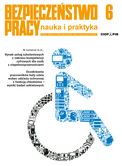Workaholism – causes, consequences, prevention
Martyna Ostrowska, Aneta Michcik
People are always in a hurry these days. Work is a very important; however, for some professional success is the utmost goal in life. Leisure time and breaks from work cause remorse. Other spheres of life, e.g., family life, rest and sleep, are neglected. The first causes for alarm are often underestimated and the worker becomes increasingly reliant on work. Workaholism leads to many negative consequences, not only for the person experiencing it, but also for the family and the workplace. Workaholism is a dangerous phenomenon because it leads to physical and mental exhaustion.
The role of the Horizontal Committee of Notified Bodies in the area of Machinery Directive 2006/42/EC in the scope of interpretation of requirements
Monika Drygała-Puto, Andrzej Dąbrowski
European coordination of notified bodies in the scope of Machinery Directive 2006/42/EC is a structure focused on providing and managing high safety standards in relation to products sold within the European Union through standardization and improvement of the activity of notified bodies that deal with machines conformity. This article presents goals and principles of the Horizontal Committee, which oversees and coordinates work of notified bodies. Preparation of documents related to Recommendations for Use are particularly stressed. This article also contains practical examples of such recommendations, which refer in detail to primary requirements of the directive, in particular regarding EC-type safety evaluations of modified machines or EC-type evaluation of new types of machines, not listed in the so-called C-type standards.
Impact of artificial light spectral characteristics on diurnal activity and sleepiness level of shift workers
Krystyna Zużewicz, Agnieszka Wolska
Light is not only part of the vision process but it also controls the secretion of sleep and thermoregulation hormones. It also influences the level of vigilance and cognitive performance. In addition to that impact of light on the human body, there is also some risk of photochemical damage of the retina, especially by blue light, which has the strongest influence on melatonin secretion. Artificial lighting of different spectral distribution characteristics can affect human psychophysiology and health. Current research aims at developing such lighting solutions for work-room lighting that would allow workers to maintain an appropriate level of vigilance and, therefore, prevent sleepiness, especially at night or in places devoid of natural light. So far, white light with a broad spectrum was most common; however, the latest trend is to use blue and green light with bands stimulating retino-hypothalamic tracts. In practice, the point is to establish such a spectral distribution of light, with significant contribution of blue light, which would to allow workers to work with high vigilance and, at the same time, would not to have a negative impact on their health.
Problematic interpretation of terms such as “particularly harmful, strenuous and dangerous work” and others
Barbara Krzyśków
This article presents an interpretation of the meaning of terms "particularly harmful work", "strenuous work", "particularly dangerous work" and "work conducted in special conditions or of special nature". It stresses the differences and discusses the legal acts with regard to circumstances where such work is done and goals towards which these acts are supposed to lead. Even though those terms are not synonyms, many people treat them as such, even some OSH experts, who assess the working environment. However, these terms serve different purposes in prevention.





























